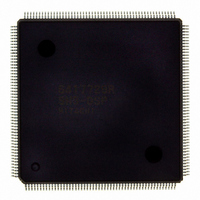D6417729RHF200BV Renesas Electronics America, D6417729RHF200BV Datasheet - Page 631

D6417729RHF200BV
Manufacturer Part Number
D6417729RHF200BV
Description
IC SUPER H MPU ROMLESS 208QFP
Manufacturer
Renesas Electronics America
Series
SuperH® SH7700r
Datasheet
1.D6417729RF133BV.pdf
(857 pages)
Specifications of D6417729RHF200BV
Core Processor
SH-3 DSP
Core Size
32-Bit
Speed
200MHz
Connectivity
EBI/EMI, FIFO, IrDA, SCI, SmartCard
Peripherals
DMA, POR, WDT
Number Of I /o
96
Program Memory Type
ROMless
Ram Size
32K x 8
Voltage - Supply (vcc/vdd)
1.85 V ~ 2.15 V
Data Converters
A/D 8x10b; D/A 2x8b
Oscillator Type
Internal
Operating Temperature
-20°C ~ 75°C
Package / Case
208-QFP Exposed Pad, 208-eQFP, 208-HQFP
Lead Free Status / RoHS Status
Lead free / RoHS Compliant
Eeprom Size
-
Program Memory Size
-
Available stocks
Company
Part Number
Manufacturer
Quantity
Price
Company:
Part Number:
D6417729RHF200BV
Manufacturer:
EVERLIGHT
Quantity:
1 000
Company:
Part Number:
D6417729RHF200BV
Manufacturer:
Renesas Electronics America
Quantity:
10 000
- Current page: 631 of 857
- Download datasheet (5Mb)
Clock: An internal clock generated by the on-chip baud rate generator or an external clock input
from the SCK pin can be selected as the SCIF transmit/receive clock. The clock source is selected
by bits CKE1 and CKE0 in the serial control register (SCSCR) (table 17.8).
When an external clock is input at the SCK pin, it must have a frequency equal to 16 times the
desired bit rate.
When the SCIF operates on an internal clock, it can output a clock signal at the SCK pin. The
frequency of this output clock is 16 times the bit rate.
Transmitting and Receiving Data (SCIF Initialization): Before transmitting or receiving, clear
the TE and RE bits to 0 in the serial control register (SCSCR), then initialize the SCIF as follows.
When changing the communication format, always clear the TE and RE bits to 0 before following
the procedure given below. Clearing TE to 0 initializes the transmit shift register (SCTSR).
Clearing TE and RE to 0, however, does not initialize the serial status register (SCSSR), transmit
FIFO data register (SCFTDR), or receive FIFO data register (SCFRDR), which retain their
previous contents. Clear TE to 0 after all transmit data has been transmitted and the TEND flag in
the SCSSR is set. The TE bit can be cleared to 0 during transmission, but the transmit data goes to
the high impedance state after the bit is cleared to 0. Set the TFRST bit in SCFCR to 1 and reset
SCFTDR before TE is set again to start transmission.
When an external clock is used, the clock should not be stopped during initialization or subsequent
operation. SCIF operation becomes unreliable if the clock is stopped.
Figure 17.5 shows a sample flowchart for initializing the SCIF. The procedure for initializing the
SCIF is:
1. Set the clock selection in SCSCR.
2. Set the communication format in SCSMR.
3. Write a value corresponding to the bit rate into the bit rate register (SCBRR).
4. Wait at least one bit interval, then set the TE bit or RE bit in SCSCR to 1. Also set the RIE
Be sure to clear bits RIE TIE, TE, and RE to 0.
When clock output is selected, the clock is output immediately after SCSCR settings are made.
(Not necessary if an external clock is used.)
and TIE bits.
Setting the TE and RE bits enables the TxD and RxD pins to be used. When transmitting, the
SCIF will go to the mark state; when receiving, it will go to the idle state, waiting for a start
bit.
Rev. 5.0, 09/03, page 583 of 806
Related parts for D6417729RHF200BV
Image
Part Number
Description
Manufacturer
Datasheet
Request
R

Part Number:
Description:
KIT STARTER FOR M16C/29
Manufacturer:
Renesas Electronics America
Datasheet:

Part Number:
Description:
KIT STARTER FOR R8C/2D
Manufacturer:
Renesas Electronics America
Datasheet:

Part Number:
Description:
R0K33062P STARTER KIT
Manufacturer:
Renesas Electronics America
Datasheet:

Part Number:
Description:
KIT STARTER FOR R8C/23 E8A
Manufacturer:
Renesas Electronics America
Datasheet:

Part Number:
Description:
KIT STARTER FOR R8C/25
Manufacturer:
Renesas Electronics America
Datasheet:

Part Number:
Description:
KIT STARTER H8S2456 SHARPE DSPLY
Manufacturer:
Renesas Electronics America
Datasheet:

Part Number:
Description:
KIT STARTER FOR R8C38C
Manufacturer:
Renesas Electronics America
Datasheet:

Part Number:
Description:
KIT STARTER FOR R8C35C
Manufacturer:
Renesas Electronics America
Datasheet:

Part Number:
Description:
KIT STARTER FOR R8CL3AC+LCD APPS
Manufacturer:
Renesas Electronics America
Datasheet:

Part Number:
Description:
KIT STARTER FOR RX610
Manufacturer:
Renesas Electronics America
Datasheet:

Part Number:
Description:
KIT STARTER FOR R32C/118
Manufacturer:
Renesas Electronics America
Datasheet:

Part Number:
Description:
KIT DEV RSK-R8C/26-29
Manufacturer:
Renesas Electronics America
Datasheet:

Part Number:
Description:
KIT STARTER FOR SH7124
Manufacturer:
Renesas Electronics America
Datasheet:

Part Number:
Description:
KIT STARTER FOR H8SX/1622
Manufacturer:
Renesas Electronics America
Datasheet:

Part Number:
Description:
KIT DEV FOR SH7203
Manufacturer:
Renesas Electronics America
Datasheet:











